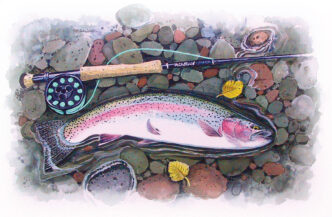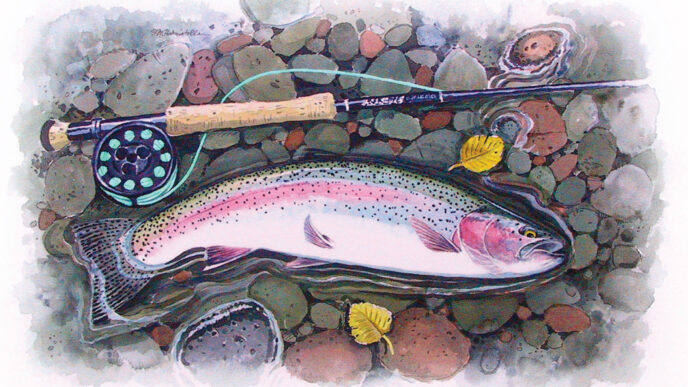This is what I call the fear of God: you’re up to your thighs in surging foam, stripping line, intent on the strike, when thirty yards away the Pacific Ocean rears up, up , and begins to curl slowly, inexorably, towards a spot situated right between your eyes. And a thought suddenly dawns on you, that maybe, just maybe , fly fishing isn’t quite the placid, gentle sport you had imagined it to be. And then –
You run like hell.
The California surf is still a new frontier for fly fishers, although a few hardy pioneers have been flinging their lines into the churn for more than a couple of decades now. As an untapped resource, the big pluses are that the ocean is no more distant than a hop and a skip for most of us, and that it contains a lot of fish, both in number and variety.
The big minuses, if you want to think of them that way, are that we’re still near the base of the learning curve, and that the ocean is, well, the ocean. As a friend of mine would say, we’re talking combat fly fishing. You make your cast, and from then on you watch the surf and not your line.
If you get a hit, you’ll know it. If you get dunked, you’ll know that, too.
I’ve been trying to figure out how to effectively fish the surf for about two years, sort of learning as I went along. I collected the appropriate tackle, I read the articles by the experts – John Shewey and Nick Curccionc – and I devoted roughly eighty hours to flogging the waves. The results were hardly worth writing about: one ten-inch rockfish and one nine-inch surfperch, and one jogger (on the backcast).
Despite this poor (okay, abysmal) rate of return, the effort wasn’t wasted. The Pacific Ocean is, after all, a darned impressive and wild place to spend one’s time, even if the bluffs behind you are lined with million-dollar homes. Plus, of course, there’s the apres surf bit: steamed clams and spicy sausages and deep fried smelt and Bloody Marys’ and ice cold beer.
Mmm, just thinking about the food and stuff gets me to searching for the tide tables!
But, you know, it’s nice to have something to show for your efforts aside from heartburn and a lurch. So, a couple of months ago I decided to part with some hard-earned cash and signed up for one of Ken Hanley’s surfperch classes. Another hit for the monkey on my back…
Five-thirty a.m. on a cold and foggy Saturday. Reg, Doc and I are huddled together in the parking lot at Moss Beach, coffee steaming into our faces, wondering what the devil we’re doing up at this pitch-black hour. A pair of headlights approaches, downshifts around the corner and slides like grease into a parking space across from us. Ken pops out of the truck, astonished.
“I’m amazed! Most of my students are late!”
We try to chuckle, unsuccessfully. Ken’s the sort of guy, though, whose enthusiasm is incredibly infectious. Imagine someone with a perpetual exclamation mark over his head. and you’ve pegged Hanley. He’s just the motivation we need at dawn.
Within minutes the four of us are chatting up a storm, hurrying into our waders, gearing up as quickly as possible to ensure that not a minute is wasted. Then, as a hazy grey light adds perspective and a hint of color to the scenery around us, we hike off to the bluffs that overlook the John Fitzgerald Marine Preserve.
The tide is at its lowest point, beginning to turn. Ken points out likely holding water that we’ll utilize during the rising ride: the edges along beds of seagrass; channels through soon-to-be submerged rocks; shelves against which fish will move. We try to take it all in, attempting with difficulty to draw some sort of correspondence with trout water. The Pacific thuds dully in the back ground, demanding attention.
We wade out to some rocks and begin casting into the unknown. A few minutes pass and Doc calls out that he had a strike. Well, maybe not. We shift location, cast along dense thickets of eelgrass. Nothing. Ken notes that the sea lions aren’t feeding: a bad sign. We walk onto a sunken shelf and cast again, again, again. The ocean roars to our rear; it’s darned hard to keep an eye on. But it energizes us, as only thoughts of a horrible death can do. The casting is good practice, too, teaching us how easily our lines entwine around seaweed and rock. The fish, if they exist, deign to ignore our offerings. The ocean thunders ever more closely, tries to lift us off our feet. Ken whistles; we reel in, pick our way across the rocks, walk thankfully onto the known solidity of the beach. Running room.
We hit a few more spots as the sea rises. Bait fishermen are beginning to show up, grabbing the better holes for themselves. Ken whistles us together. “Well guys, we’re past the peak. I think we should call it a day.”
We agree, and agree to meet in town for lunch (clam chowder and steam beer), and agree to meet again the next morning.
Dawn again, but this time we’re short Doc, who apparently fell asleep during the opera the night before and, surprisingly, took it as a bad sign. Today. our objective is to fish a sandy beach rather than a rocky shoreline.
Exclamation marks appear above Ken’s head as he moves us down the beach, showing us troughs and channels, summarizing the hydraulics that define holding water in what seems an aquatic Sahara.
Reg and I wade into the ocean, turn sideways so that the brunt of the surf hits us along our narrowest dimension. And hit we are with spray and grit flying into our faces and down our waders, sand sucking from beneath our feet. It’s about as intense as, well, the ol’ you know what.
Reg casts into a hole in front of us, strips line quickly, cases once more, then yells, ‘I’ve hooked a fish!’ I look up and see Reg’s rod bent deeply in an arc, throbbing to something with a lot more fight than a hunk of kelp.
At that same moment I feel a tap on my line, then a sharp tug, and I set the hook – ‘fish on!’ It uses the surf to its advantage, crying to escape on the undertow, but I muscle the thing in with my eight-weight. It’s a 10-inch surfperch, silver bright. Reg holds up his catch – 12-inches. These aren’t big fish – surfperch usually aren’t – but we grin, and Ken gives us both high fives…
and I know then that I’ll be back.
CLEANING YOUR GEAR
Saltwater does horrible things to metal, and it isn’t exactly great for other materials as well. You should try and clean your gear within 12 hours of leaving the surf – and preferably much sooner. First, hose everything off. Then, strip from your reel the amount of line that had contact in saltwater, plus about 10 to 20 feet of extra; wash the reel (making sure to first pull spool from housing), stripped line, flies and other metallic bits and pieces in warm water. (You can do the warm-water washing in the shower, by the way.) Take a used toothbrush and scrub the ferrules, guides and reel seat of your rod. If possible, soak the reel and flies for an hour or more in hot water; this will leach away saltwater that may have snuck into hard-to-reach nooks and crannies. Dress the line after it is dry, then reassemble reel.
– Richard Anderson














